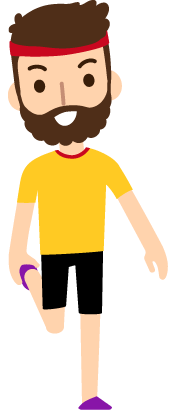We go running.
We finish running.
Then what do we do?
Some of us hop off the treadmill. Others end at the trailhead or a parking lot. Many return to our own front door.
Most often, we get in the vehicle and drive to the next thing in life or take a quick shower.
Post-run recovery matters just as much as the run itself. So, enter yoga for runners.
“I’m not flexible enough for yoga.”
“I thought yoga/stretching wasn’t good for runners.”
Furthermore, yoga is a dynamic, heat-building practice that encompasses:
In other words, yoga is not simply sitting on your butt, passively stretching or pulling yourself into contorted, painful shapes.
1. Yoga allows us to bring down the high vibration of running by utilizing deep BREATHING.
2. The BREATH allows us to bring the energy back into homeostasis, particularly after high intensity, hill repeat, speed-focused or interval runs.
3. When we BREATHE deeply, we activate the parasympathetic nervous system, which controls the restorative center of our body, allowing for optimal post-run recovery.
4. When synching BREATH with movement while flowing through yoga postures, we train ourselves to sync BREATH with movement outside of yoga, i.e., daily life.
5. Yoga poses are the catalysts to prompt us to use our BREATH.
So let’s get to it. Where were we?
We just finished running.
Let’s transition to the next thing in life slowly, with rest, refueling, and post-run yoga.
Do not:
The following series is what I do most frequently when I arrive off the trail and back to my vehicle, which I use as a prop, at the trailhead.
If you are at a gym, track, park or at home, use a wall or steps as your prop.
Benefits:
Benefits:
Benefits:
Make it dynamic:
Benefits:
Make it dynamic:
Benefits:
Make it dynamic:
Benefits:
Make it dynamic:
Benefits:
Make it dynamic:
Benefits:
Make it dynamic:
Benefits:
Make it dynamic:
Benefits:
If ten poses seems like too many, start with one pose and hold it for three breaths per side.
The next day, choose another pose. Play with the sequence.
Are your calves pretty loose? Then skip some of the calf-focused poses.
Keep adding poses and the number of breaths until you tailor your post-run yoga session to meet your wants and needs. Some days you’ll have time for more, some days less.
The purpose is to decompress and settle into the breath in order to elevate your recovery experience, which is as equally important as your training session.
Happy running and happy yoga!
Favorite Yoga app for daily morning practice:
What Brynn’s wearing:
Brynn Cunningham received her 230-hour yoga instructor certification from the Asheville Yoga Center (AYC) in North Carolina in 2015. Prior to formal training, she began teaching at community centers in 2011.
She took her first yoga class at age 18, in 2001, when someone suggested it would be good for her as a runner. Yoga became a daily practice for her in 2009.
Each morning, she wakes up and practices for 60 to 90 minutes to begin the day with the breath and movement.
Brynn founded Inhale Exhale Run first as a blog where she could write about yoga and running and then as a way to bring Yoga for Runners Workshops and yoga classes to groups and studios.
Past and present yoga clients and teaching locations include:
Photography by Colleen O’Neil

Rob Myers My flexibility is terrible! Thanks for dropping the Yoga knowledge Brynn. Great Rundown!
Brynn Cunningham Thank you! Two more post-yoga for runners coming soon!
Login to your account to leave a comment.





We Want to Give it to You!
